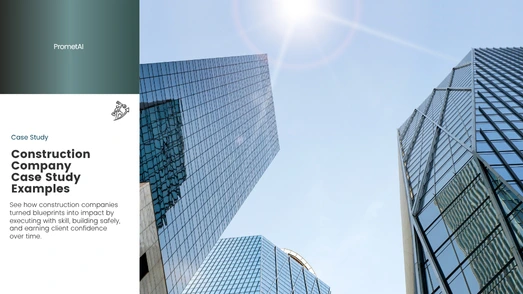Explore real-world construction company case study examples on sustainable design, predictive analytics, and complex project delivery.
Case Study 1: How Bechtel Delivered London’s Crossrail, Europe’s Largest Infrastructure Project
Delivering a railway under one of the world’s busiest cities required excellence in planning, technology, and teamwork. The Crossrail project, now proudly known as the Elizabeth Line, became a landmark example of modern infrastructure project management. Bechtel harnessed advanced digital project management tools, real time data integration, and predictive analytics in construction industry to ensure this immense endeavor stayed on track.
The company turned complexity into coordination, building not just tunnels and stations but also a new global model for precision, safety, and performance in smart construction technology.
About the Business
Bechtel Group, Inc. is a global leader in engineering and construction, headquartered in Reston, Virginia. The company operates in more than 160 countries and generates over 20 billion dollars in annual revenue. Its long-standing reputation for excellence comes from successfully managing large-scale infrastructure project management initiatives across the energy, civil, and transportation infrastructure sectors.
Bechtel is recognized for its ability to plan, coordinate, and deliver complex projects that shape modern cities and economies. Its focus on innovation, safety, and precision continues to set new standards for how global infrastructure is designed and built.
The Crossrail project, now known as the Elizabeth Line, stood among Europe’s largest and most technically demanding transportation initiatives. Spanning 42 kilometers beneath central London, it required an extraordinary level of coordination, safety, and precision.
Bechtel faced several major challenges:
Coordinating over 10,000 workers across 40 construction sites operating simultaneously.
Managing multiple government and regulatory stakeholders with varying objectives.
Ensuring compliance with strict safety standards while maintaining productivity.
Working within the dense and complex infrastructure of central London, where space and timing left no margin for error.
Preventing delays and cost overruns on one of the most closely watched infrastructure projects in Europe.
To succeed, Bechtel needed a management system capable of uniting teams, data, and operations in real time. The solution had to ensure efficiency, transparency, and absolute control from the first excavation to final delivery.
Bechtel introduced a comprehensive digital project management system designed to handle the scale and complexity of Crossrail. The approach focused on real time data integration and predictive analytics in construction industry to enhance planning, coordination, and safety.
The company’s main initiatives included:
Digital twin technology: Developed virtual models of tunnels and stations to simulate construction sequences, forecast potential risks, and plan work with greater precision.
Predictive analytics in construction industry: Used data insights to anticipate schedule changes, cost pressures, and safety concerns before they occurred.
Automation in construction: Applied automated scheduling and resource allocation to improve coordination across more than forty active sites.
Construction safety technology: Implemented predictive safety algorithms that reduced risk exposure and strengthened on-site safety management.
All project data, including scheduling, procurement, and workforce performance, was unified under one centralized digital platform accessible to both on-site managers and city authorities.
This connected ecosystem of smart construction technology improved transparency, accelerated communication, and allowed Bechtel to manage the project with greater precision and confidence.
The Results
The results redefined what a megaproject could achieve.
Operational efficiency improved by 22 percent
On-site incidents dropped by 30 percent
Ninety-four percent of project milestones were achieved on time
Such performance set a new benchmark for infrastructure project management in complex urban environments. The Crossrail delivery now serves as a global model for how digital coordination and intelligent forecasting can reshape the future of construction.
Development Path
Between 2012 and 2016, Bechtel led the tunneling and station construction phase beneath London’s dense cityscape. Coordinating thousands of specialists and maintaining strict safety standards, the company kept progress steady in one of the world’s most challenging urban environments.
From 2017 to 2021, attention turned to system integration and safety testing. Bechtel’s teams synchronized mechanical, electrical, and digital systems to create a fully connected network ready for operation.
In 2022, the Elizabeth Line opened to the public, marking a defining moment in British infrastructure. The project stood as proof of Bechtel’s ability to turn complexity into precision and vision into reality.
Key Takeaways
Bechtel’s delivery of the Crossrail project highlights how digital precision and predictive planning can reshape large-scale construction. Every phase of the project reflected the power of coordination, data, and innovation in transportation infrastructure.
Centralized data systems united schedules, procurement, and workforce performance, giving every team real-time visibility.
Predictive modeling improved safety and accuracy by identifying potential risks before they affected timelines.
Automation and digital twins brought efficiency to scheduling and resource management, reducing complexity across sites.
Collaborative digital ecosystems strengthened communication and alignment among thousands of workers and multiple government stakeholders.
The Crossrail achievement proves that when digital tools and human expertise operate together, infrastructure delivery reaches new levels of safety, speed, and reliability.
